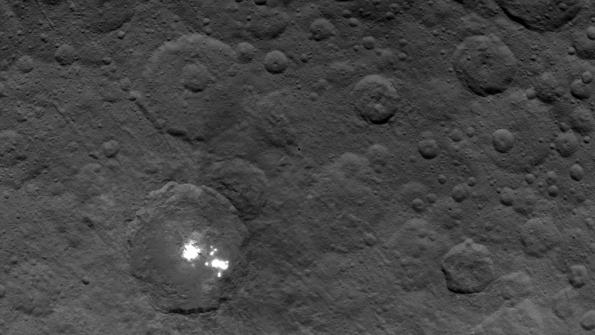Dawn Prolongs 2nd Reconnaissance Orbit at Ceres After Orientation Issue

Momentarily flying in the shadow of New Horizons fast approaching close encounter with distant Pluto, NASA's ground breaking Dawn mission at the large asteroid Ceres provided some recent drama of its own.

Earlier this month, Dawn emerged from a safe mode triggered by the spacecraft on June 30 after activating its ion propulsion system to take the third in a series of steps closer to the surface of the heavily cratered asteroid. The difficult was linked to the spacecraft's orientation control system.
Ceres has gained fame for its mysterious bright spots, hints of a tenuous atmosphere and speculation that it may host subsurface water.
In March, Dawn earned the distinction of becoming the first spacecraft to visit a minor planet -- four months ahead of New Horizons' Pluto flyby.
As a result of the safe mode incident, Dawn is hanging in at its second mapping orbit a little longer than originally envisioned while engineers at NASA's Jet Propulsion Laboratory unravel the reasons for the incident and replan. The spacecraft was out of safe mode and communicating with Earth again normally by July 6, according to Marc Rayman, the Dawn mission director.
Just prior to entering safe mode, Dawn's telemetry revealed resets of the computers that manage cameras and an infrared mapping spectrometer on the probe.
The $472 million Dawn mission was launched on Sept. 27, 2007, 15 months after New Horizons sprinted away from Earth for its July 14 flyby of Pluto. New Horizons lapsed into safe mode briefly on July 4 as mission managers prepared spacecraft computers for the Pluto encounter.
Dawn maneuvered into orbit around Ceres on Mar. 6, after an orbital visit to Vesta, a second main belt asteroid, between September 2011 and September 2012.
The initial Ceres exploration strategy called for a succession of gradually lower altitude reconnaissance sessions, starting with Rotation Characterization Orbit 3, between late April and early May.
The recently extended current phase began June 5, with Dawn orbiting Ceres every 3.1 days at 2,700 miles altitude, close enough to reveal curving canyons among the craters on Ceres, though still too distant to produce an explanation for the bright features.
In his JPL update, Rayman stressed the mission's versatility due in large part to the ion propulsion system. That flexibility eliminates special windows of opportunity for each reconnaissance phase.
"The plans for the third and fourth mapping orbits can be shifted to new dates without significant changes in objectives or productivity," Rayman stated.
Once the recent difficulties are sorted out, Dawn will move to the High Altitude Mapping Orbit, notionally from Aug. 4 to Oct. 15, orbiting once every 19 hours at 900 miles.
During the final reconnaissance phase, the Low Altitude Mapping Orbit, targeted early on to begin Dec. 8 and extend through the end of mission in mid-2016, Dawn will descend to 230 miles and orbit every 5 1/2 hours.